#gifts for makers
Text

The last label one of these ever made read "TRASH BIN OF HISTORY".
Life - December 13, 1963
#1963#label maker#office equipment#vintage ad#advertising#advertisement#Christmas gifts#Christmas ad#Vintage Christmas#Christmas#Xmas ad#xmas#1960s#1960s ad#1960's#1960's ad#funny#humor#humour
481 notes
·
View notes
Text

You miss him?
#star wars#the bad batch#bad batch#Crosshair#the bad batch crosshair#clones#tbb#tbb crosshair#pin up#gift art#digital art#procreate#drawn for a pin maker on Instagram cause they’re awesome and I wanted to bribe them to make their Crosshair and open preorder xD
371 notes
·
View notes
Text
Brian Merchant’s “Blood In the Machine”
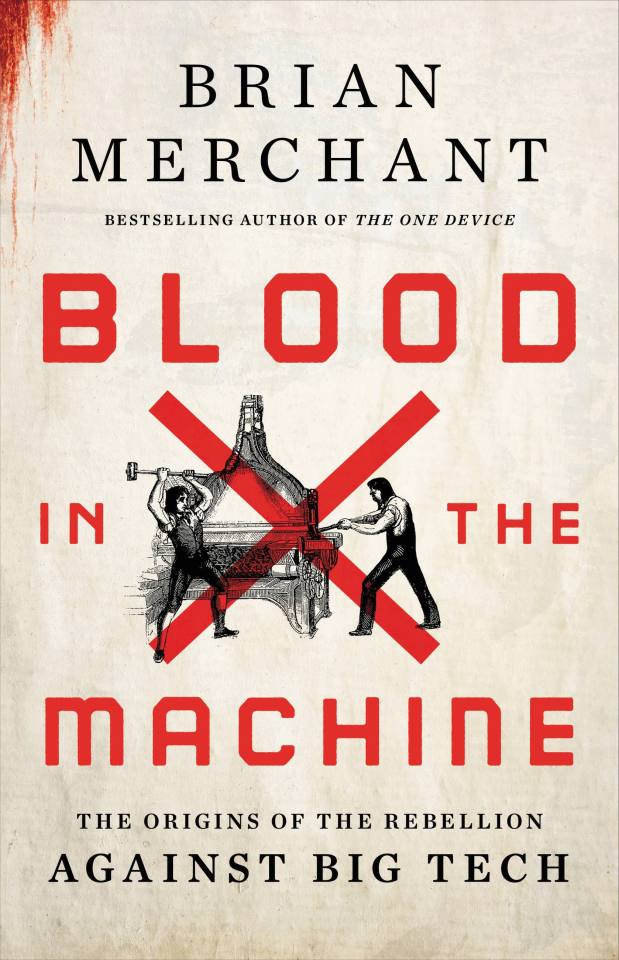
Tomorrow (September 27), I'll be at Chevalier's Books in Los Angeles with Brian Merchant for a joint launch for my new book The Internet Con and his new book, Blood in the Machine. On October 2, I'll be in Boise to host an event with VE Schwab.

In Blood In the Machine, Brian Merchant delivers the definitive history of the Luddites, and the clearest analysis of the automator's playbook, where "entrepreneurs'" lawless extraction from workers is called "innovation" and "inevitable":
https://www.littlebrown.com/titles/brian-merchant/blood-in-the-machine/9780316487740/
History is written by the winners, and so you probably think of the Luddites as brainless, terrified, thick-fingered vandals who smashed machines and burned factories because they didn't understand them. Today, "Luddite" is a slur that means "technophobe" – but that's neither fair, nor accurate.
Luddism has been steadily creeping into pro-labor technological criticism, as workers and technology critics reclaim the term and its history, which is a rich and powerful tale of greed versus solidarity, slavery versus freedom.
The true tale of the Luddites starts with workers demanding that the laws be upheld. When factory owners began to buy automation systems for textile production, they did so in violation of laws that required collaboration with existing craft guilds – laws designed to ensure that automation was phased in gradually, with accommodations for displaced workers. These laws also protected the public, with the guilds evaluating the quality of cloth produced on the machine, acting as a proxy for buyers who might otherwise be tricked into buying inferior goods.
Factory owners flouted these laws. Though the machines made cloth that was less durable and of inferior weave, they sold it to consumers as though it were as good as the guild-made textiles. Factory owners made quiet deals with orphanages to send them very young children who were enslaved to work in their factories, where they were routinely maimed and killed by the new machines. Children who balked at the long hours or attempted escape were viciously beaten (the memoir of one former child slave became a bestseller and inspired Oliver Twist).
The craft guilds begged Parliament to act. They sent delegations, wrote petitions, even got Members of Parliament to draft legislation ordering enforcement of existing laws. Instead, Parliament passed laws criminalizing labor organizing.
The stakes were high. Economic malaise and war had driven up the price of life's essentials. Workers displaced by illegal machines faced starvation – as did their children. Communities were shattered. Workers who had apprenticed for years found themselves graduating into a market that had no jobs for them.
This is the context in which the Luddite uprisings began. Secret cells of workers, working with discipline and tight organization, warned factory owners to uphold the law. They sent letters and posted handbills in which they styled themselves as the army of "King Ludd" or "General Ludd" – Ned Ludd being a mythical figure who had fought back against an abusive boss.
When factory owners ignored these warnings, the Luddites smashed their machines, breaking into factories or intercepting machines en route from the blacksmith shops where they'd been created. They won key victories, with many factory owners backing off from automation plans, but the owners were deep-pocketed and determined.
The ruling Tories had no sympathy for the workers and no interest in upholding the law or punishing the factory owners for violating it. Instead, they dispatched troops to the factory towns, escalating the use of force until England's industrial centers were occupied by literal armies of soldiers. Soldiers who balked at turning their guns on Luddites were publicly flogged to death.
I got very interested in the Luddites in late 2021, when it became clear that everything I thought I knew about the Luddites was wrong. The Luddites weren't anti-technology – rather, they were doing the same thing a science fiction writer does: asking not just what a new technology does, but also who it does it for and who it does it to:
https://locusmag.com/2022/01/cory-doctorow-science-fiction-is-a-luddite-literature/
Unsurprisingly, ever since I started publishing on this subject, I've run into people who have no sympathy for the Luddite cause and who slide into my replies to replicate the 19th Century automation debate. One such person accused the Luddites of using "state violence" to suppress progress.
You couldn't ask for a more perfect example of how the history of the Luddites has been forgotten and replaced with a deliberately misleading account. The "state violence" of the Luddite uprising was entirely on one side. Parliament, under the lackadaisical leadership of "Mad King George," imposed the death penalty on the Luddites. It wasn't just machine-breaking that became a capital crime – "oath taking" (swearing loyalty to the Luddites) also carried the death penalties.
As the Luddites fought on against increasingly well-armed factory owners (one owner bought a cannon to use on workers who threatened his machines), they were subjected to spectacular acts of true state violence. Occupying soldiers rounded up Luddites and suspected Luddites and staged public mass executions, hanging them by the dozen, creating scores widows and fatherless children.
The sf writer Steven Brust says that the test to tell whether someone is on the right or the left is simple: ask whether property rights are more important than human rights. If the person says "property rights are human rights," they are on the right.
The state response to the Luddites crisply illustrates this distinction. The Luddites wanted an orderly and lawful transition to automation, one that brought workers along and created shared prosperity and quality goods. The craft guilds took pride in their products, and saw themselves as guardians of their industry. They were accustomed to enjoying a high degree of bargaining power and autonomy, working from small craft workshops in their homes, which allowed them to set their own work pace, eat with their families, and enjoy modest amounts of leisure.
The factory owners' cause wasn't just increased production – it was increased power. They wanted a workforce that would dance to their tune, work longer hours for less pay. They wanted unilateral control over which products they made and what corners they cut in making those products. They wanted to enrich themselves, even if that meant that thousands starved and their factory floors ran red with the blood of dismembered children.
The Luddites destroyed machines. The factory owners killed Luddites, shooting them at the factory gates, or rounding them up for mass executions. Parliament deputized owners to act as extensions of law enforcement, allowing them to drag suspected Luddites to their own private cells for questioning.
The Luddites viewed property rights as just one instrument for achieving human rights – freedom from hunger and cold – and when property rights conflicted with human rights, they didn't hesitate to smash the machines. For them, human rights trumped property rights.
Their bosses – and their bosses' modern defenders – saw the demands to uphold the laws on automation as demands to bring "state violence" to bear on the wholly private matter of how a rich man should organize his business. On the other hand, literal killing – both on the factory floor and at the gallows – was not "state violence" but rather, a defense of the most important of all the human rights: the rights of property owners.
19th century textile factories were the original Big Tech, and the rhetoric of the factory owners echoes down the ages. When tech barons like Peter Thiel say that "freedom is incompatible with democracy," he means that letting people who work for a living vote will eventually lead to limitations on people who own things for a living, like him.
Then, as now, resistance to Big Tech enjoyed widespread support. The Luddites couldn't have organized in their thousands if their neighbors didn't have their backs. Shelley and Byron wrote widely reproduced paeans to worker uprisings (Byron also defended the Luddites in the House of Lords). The Brontes wrote Luddite novels. Mary Shelley's Frankenstein was a Luddite novel, in which the monster was a sensitive, intelligent creature who merely demanded a say in the technology that created him.
The erasure of the true history of the Luddites was a deliberate act. Despite the popular and elite support the Luddites enjoyed, the owners and their allies in Parliament were able to crush the uprising, using mass murder and imprisonment to force workers to accept immiseration.
The entire supply chain of the textile revolution was soaked in blood. Merchant devotes multiple chapters to the lives of African slaves in America who produced the cotton that the machines in England wove into cloth. Then – as now – automation served to obscure the violence latent in production of finished goods.
But, as Merchant writes, the Luddites didn't lose outright. Historians who study the uprisings record that the places where the Luddites fought most fiercely were the places where automation came most slowly and workers enjoyed the longest shared prosperity.
The motto of Magpie Killjoy's seminal Steampunk Magazine was: "Love the machine, hate the factory." The workers of the Luddite uprising were skilled technologists themselves.
They performed highly technical tasks to produce extremely high-quality goods. They served in craft workshops and controlled their own time.
The factory increased production, but at the cost of autonomy. Factories and their progeny, like assembly lines, made it possible to make more goods (even goods that eventually rose the quality of the craft goods they replaced), but at the cost of human autonomy. Taylorism and other efficiency cults ended up scripting the motions of workers down to the fingertips, and workers were and are subject to increasing surveillance and discipline from their bosses if they deviate. Take too many pee breaks at the Amazon warehouse and you will be marked down for "time off-task."
Steampunk is a dream of craft production at factory scale: in steampunk fantasies, the worker is a solitary genius who can produce high-tech finished goods in their own laboratory. Steampunk has no "dark, satanic mills," no blood in the factory. It's no coincidence that steampunk gained popularity at the same time as the maker movement, in which individual workers use form digital communities. Makers networked together to provide advice and support in craft projects that turn out the kind of technologically sophisticated goods that we associate with vast, heavily-capitalized assembly lines.
But workers are losing autonomy, not gaining it. The steampunk dream is of a world where we get the benefits of factory production with the life of a craft producer. The gig economy has delivered its opposite: craft workers – Uber drivers, casualized doctors and dog-walkers – who are as surveilled and controlled as factory workers.
Gig workers are dispatched by apps, their faces closely studied by cameras for unauthorized eye-movements, their pay changed from moment to moment by an algorithm that docks them for any infraction. They are "reverse centaurs": workers fused to machines where the machine provides the intelligence and the human does its bidding:
https://pluralistic.net/2021/02/17/reverse-centaur/#reverse-centaur
Craft workers in home workshops are told that they're their own bosses, but in reality they are constantly monitored by bossware that watches out of their computers' cameras and listens through its mic. They have to pay for the privilege of working for their bosses, and pay to quit. If their children make so much as a peep, they can lose their jobs. They don't work from home – they live at work:
https://pluralistic.net/2021/01/22/paperback-writer/#toothless
Merchant is a master storyteller and a dedicated researcher. The story he weaves in Blood In the Machine is as gripping as any Propublica deep-dive into the miserable working conditions of today's gig economy. Drawing on primary sources and scholarship, Blood is a kind of Nomadland for Luddites.
Today, Merchant is the technology critic for the LA Times. The final chapters of Blood brings the Luddites into the present day, finding parallels in the labor organizing of the Amazon warehouse workers led by Chris Smalls. The liberal reformers who offered patronizing support to the Luddites – but didn't imagine that they could be masters of their own destiny – are echoed in the rhetoric of Andrew Yang.
And of course, the factory owners' rhetoric is easily transposed to the modern tech baron. Then, as now, we're told that all automation is "progress," that regulatory evasion (Uber's unlicensed taxis, Airbnb's unlicensed hotel rooms, Ring's unregulated surveillance, Tesla's unregulated autopilot) is "innovation." Most of all, we're told that every one of these innovations must exist, that there is no way to stop it, because technology is an autonomous force that is independent of human agency. "There is no alternative" – the rallying cry of Margaret Thatcher – has become our inevitablist catechism.
Squeezing the workers' wages conditions and weakening workers' bargaining power isn't "innovation." It's an old, old story, as old as the factory owners who replaced skilled workers with terrified orphans, sending out for more when a child fell into a machine. Then, as now, this was called "job creation."
Then, as now, there was no way to progress as a worker: no matter how skilled and diligent an Uber driver is, they can't buy their medallion and truly become their own boss, getting a say in their working conditions. They certainly can't hope to rise from a blue-collar job on the streets to a white-collar job in the Uber offices.
Then, as now, a worker was hired by the day, not by the year, and might find themselves with no work the next day, depending on the whim of a factory owner or an algorithm.
As Merchant writes: robots aren't coming for your job; bosses are. The dream of a "dark factory," a "fully automated" Tesla production line, is the dream of a boss who doesn't have to answer to workers, who can press a button and manifest their will, without negotiating with mere workers. The point isn't just to reduce the wage-bill for a finished good – it's to reduce the "friction" of having to care about others and take their needs into account.
Luddites are not – and have never been – anti-technology. Rather, they are pro-human, and see production as a means to an end: broadly shared prosperity. The automation project says it's about replacing humans with machines, but over and over again – in machine learning, in "contactless" delivery, in on-demand workforces – the goal is to turn humans into machines.
There is blood in the machine, Merchant tells us, whether its humans being torn apart by a machine, or humans being transformed into machines.
Brian and I are having a joint book-launch tomorrow night (Sept 27) at Chevalier's Books in Los Angeles for my new book The Internet Con and his new book, Blood in the Machine:
https://www.eventbrite.com/e/the-internet-con-by-cory-doctorow-blood-in-the-machine-by-brian-merchant-tickets-696349940417



If you'd like an essay-formatted version of this post to read or share, here's a link to it on pluralistic.net, my surveillance-free, ad-free, tracker-free blog:
https://pluralistic.net/2023/09/26/enochs-hammer/#thats-fronkonsteen
#pluralistic#books#reviews#brian merchant#luddism#automation#history#gift guide#steampunk#makers#tina#inevitablism#reverse centaurs#amazon#arise
547 notes
·
View notes
Text

gift for @revacholianpizzaagenda for the @palestaticexchange !! something something slight invasion of personal space
#pale static gift exchange#hope you like it!!!#disco elysium#my art#steban the student communist#echo maker
151 notes
·
View notes
Text
*Skitters up to you on all fours and drops this in your lap, then scrambles up the walls and onto the ceiling and immediately falls asleep*
Comic time! Lucky wakes up in the middle of the night and has a chat with Sen in this one.
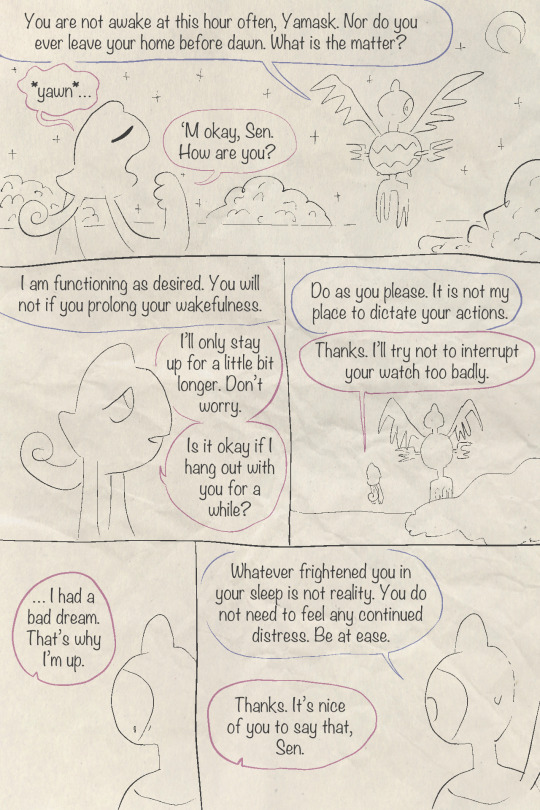
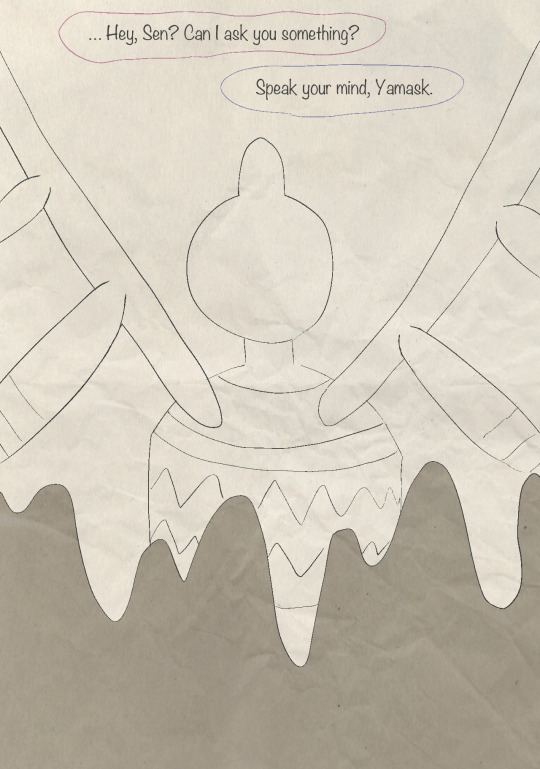

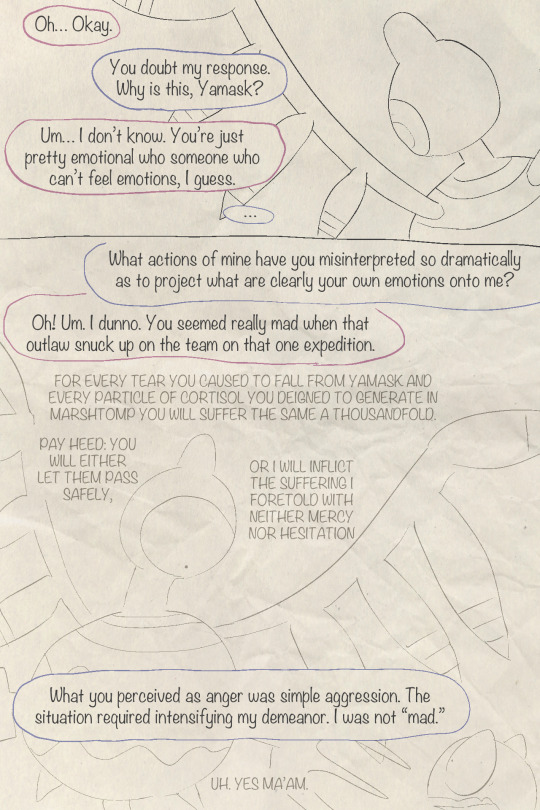
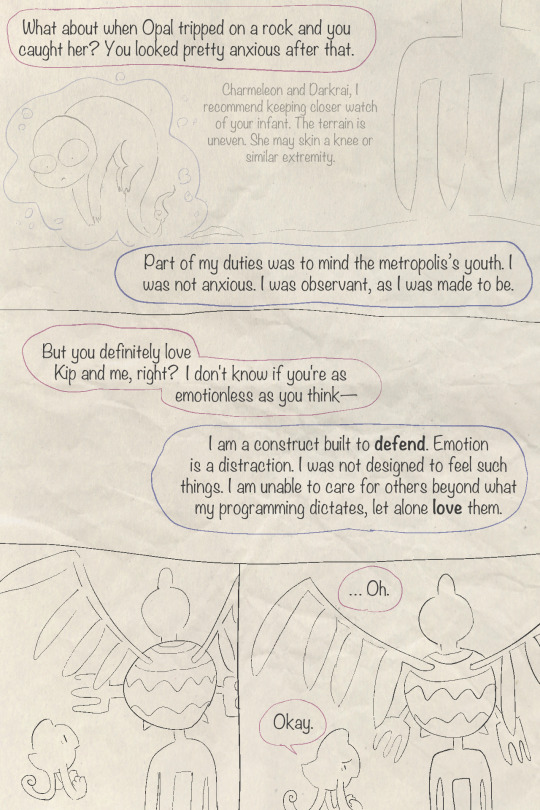
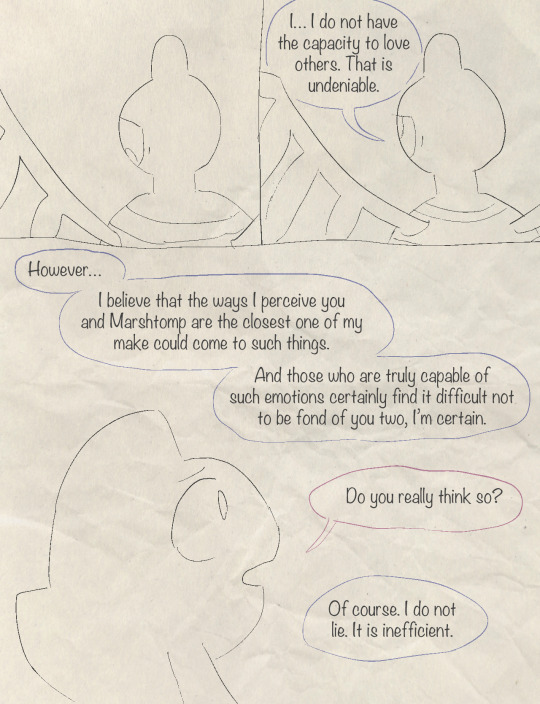
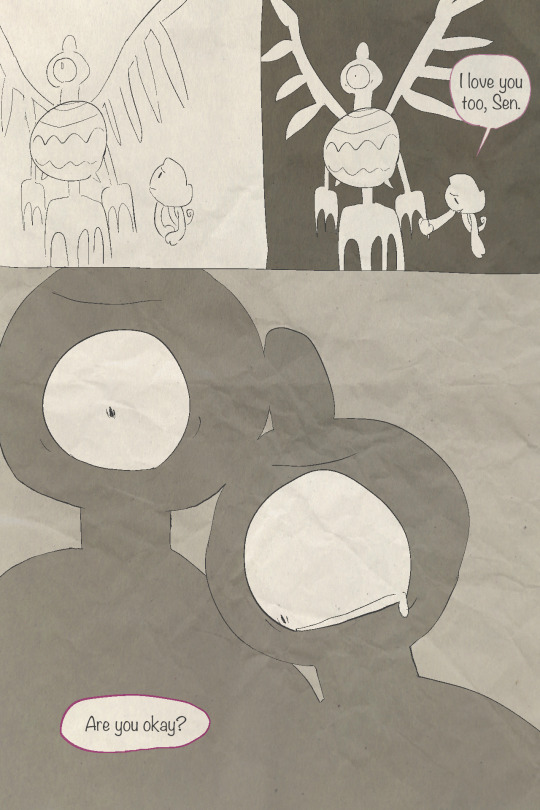
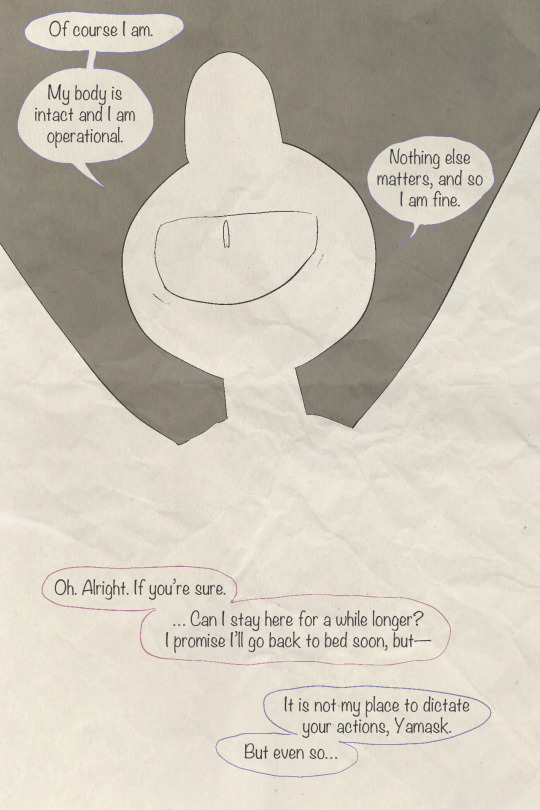
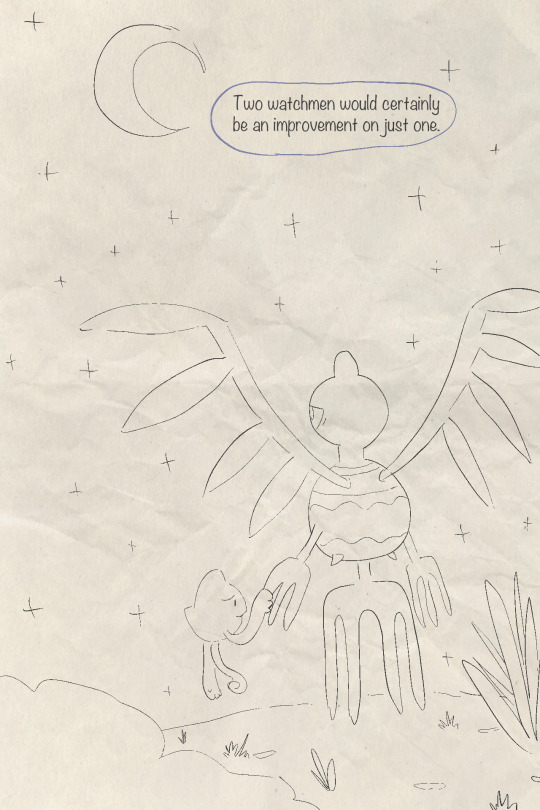
#ah yes. the struggle of seeing yourself as a machine incapable of truly having an emotional connection with others#no matter how deeply you long for such things#whilst simultaneously seeing that deep longing within you as a mistake. a flaw. an imperfection#you were made to be absolute and impartial#to be biased in favor of your charges beyond that which your ‘programming’ dictates is shameful#you are broken. you are flawed. you want and you want and you want and you’ve never stopped /wanting./#you aren’t supposed to worry or care or love. you weren’t made for it.#and if you were not made for it then you simply cannot worry or care or love.#these /things/ that haunt you and make you inefficient are not emotions.#they are your imperfections; flaws in your make; symbols of your failures to live up to your purpose#you are broken. you are flawed. and you want so deeply that you can scarcely keep the longing inside you#such a failure you are; to not only survive the fall of the metropolis you were built to give your life to defend#but also to stoop to and revel in such indulgent imperfections as these false emotions the moment your makers are gone to dust#Fun Fact! Sen doesn’t require sleep#and spends every evening standing outside of Sharpedo Bluff / whatever campsite the gang have set up to guard the entrance.#she doesn't stay inside at night because it wasn't something done in the metropolis she hails from.#sentries are meant to watch over their charges. they are not meant to indulge in the pleasant and dry warmth of their homes.#Kip hears about this eventually (he thought it was just Sen not trusting people enough to sleep around them) and FLIPS OUT#“PLEASE would you come inside IT'S LITERALLY HAILING”#Sen is taking so much hail damage and has the gall to look at him and say “You should return to your home. the weather is unfavorable”#Kip just screams into his hands because he might have found someone even worse at self-care than Twig#And with that#it is beddy-bye time for Sofie :)#the present is a gift au#pmd oc#pmd ocs#pokemon mystery dungeon#pokémon mystery dungeon#pmd explorers#pmd eos
86 notes
·
View notes
Text


Gift Wrapped Dice Set 🎁 Unpainted Gothic Numbering
#numbers to be painted on orders#dice#dnd#dice maker#dicemaker#dice set#handmade#resin#ttrpg#dnd dice set#dungeons and dragons#gift#gift dice#dice bag#dice game#rpg dice#dice aesthetic#dice goblin#dnd dice#dungeons and dragons dice#handmade dice#polyhedral dice#resin dice#ttrpg dice set#ttrpg art
207 notes
·
View notes
Text
sorry for the lack of posts, i've been making a game for the past month. release on itch in ~2 weeks
#dev#babys first unity game#my past experience consisted of rpg maker lua danmakufu and basic vanilla langs#im not making this alone! i have a 3d artist and a lead designer behind this#im basically just helping out in building everything#as a gift for our dear friend#but i hope i can continue pursuing gamedev in that direction#please dont expect much from me lol
98 notes
·
View notes
Photo






blue joon ♡ for @rkivedfiles
cr. namuspromised
#btsgif#dailybts#networkbangtan#bangtanarmynet#houseofddaeng#btshoneyhive#usersky#namjoon#*nj#*gifs#*comp#dearest erl - happiest of birthdays to you!!#I hope you have a really really great day filled with love and happiness and presents and fun and everything you wish for <33#it feels good to finally give something back to THE birthday gift set maker we have here!#thank you for blessing us with your kindness 365 days a year#my subtle question about your favourite colour very obviously has nothing to do with the idea behind this set duh#haha I hope you like it angel#sending you lots of love <33#(I don't know why the quality turned out so bad ... I really don't :/ )
1K notes
·
View notes
Text

Tragic Doomed Yaoi (French Variant)
#pokemon#pokemas#pokemon xy#professor sycamore#flare boss lysandre#perfectworldshipping#this photo maker is the gift that keeps on giving
117 notes
·
View notes
Text
dont get me wrong while uli learning disco dancing and other horrifically outdated ways to pick up dates with harry is absolutely fucking hilarious i feel as if he would naturally gravitate towards kim more. not just because of the nilsen parallel but because he wants to be taken Seriously. and here is this very Serious (lonely) man who is Serious (repressed) about the way he loves and he drives a car despite being legally blind (stubborn) and has beaten the odds of survival time and time again (at the expense of others; which he feels as if he does not deserve). ulixes will learn Something from kim but it certainly won't be related to how to get steban to like him.
#kim probably wouldnt let uli anywhere near his gun so shooting's off the table#their interactions are more akin to 'estranged uncle drives you to a pretty place and#you both stiltedly philosophize on whether the love is worth the grief'#and then he shows you his cool camera and maybe get into photography since ampoules are cheap#and then maybe you build a collection of pretty photgraphs. you're an amateur but surely steban will see the beauty of them. right?#countless nights and days. whenever kim's free to drive you around to places you've seen a picture in#and then you place a photograph between each page of a new book of theory and gift it to Steban.#what comes next? uh... i'll write this fic someday 🧍♂️🏃♂️#disco elysium#echo maker#ulixes bücher#txt#steban the student communist
283 notes
·
View notes
Text
when i get a bread maker it's so over for you fuckers
#kneading and bread proofing is so burdensome to me#but if I have a bread maker that has an automatic mixing and proofing cycle??#it's bread city#i'm passing off loaves to anyone that'll take one#my mother has an old machine that was gifted to her that she doesn't want and has offered it to me#along with her grocery cart#catch me rollin' my groceries home and feeding homemade bread to the pigeons
53 notes
·
View notes
Text

"PEW PEW PEW"
"Did you say something Honey?"
"Nothing Dear. pew pew pew."
American Home December 1964
#label maker#dymo#1964#office equipment#vintage ad#advertising#advertisement#Christmas gifts#Christmas ad#Vintage Christmas#Christmas#Xmas ad#xmas#1960s#1960s ad#1960's#1960's ad#funny#humor#humour
72 notes
·
View notes
Text
.
#prefacing this in saying that this isn't directed at anyone reposting these from twit or reblogging them#I need to get this frustration out though#and maybe some other artists will feel seen with this#but like.#AI is a devaluation of everything fandom is built on and i am disgusted by it#the economy of fandom is based on creation made and gifted and created in return#everything AI makes is stolen from what other have created#their fan art or their fic or their manips or their photography#ALL of it is stolen#every bit of it#that has been taken from someone who has made something out of love#AI might create fun images#but ive seen so much ai 'fanart' on twitter today#and i can so CLEARLY name every artist that that 'fanart' has stolen from#its fucking sickening#and we dont have as many manip makers in our fandom right now but we have a rich history of it#and i feel sick thinking about how they will think its useless to even try now#when people can just ~make ai manips~#BUT ITS NOT THE SAME#with fan art and manips i spend so much time zooming in and looking at details and expressions#knowing those have been created with a purpose#theyre made to be found and admired#ai 'art' has none of that#and im just#so mad#fuck ai fuck ai fuck ai im so MAD#it is a DEVALUATION OF FANDOM I AM SO MAD#not at the people using it as much#because i feel like they havent thought through that#although i hope they will
80 notes
·
View notes
Text



IMAGE ID: 3 rectangular flags with 9 stripes. The middle flag has vertical stripes instead of horizontal. The stripes are, in order: pale pastel green, light teal, blue, dark blue, pale lavender, dark purple, pink, pastel pink, beige. END OF ID.
✦︰︵︵ ANDROGYNE REDESIGN
EXPLANATIONS ✦ ╲╲ ︶︶︶︶︶︶︶︶︶︶︶
A redesign of the androgyne flag based on the common androgyne flag!!
Here are some other alternatives;; (☆) (☆) (☆)
MEANINGS ✦ ╲╲ ︶︶︶︶︶︶︶︶︶︶︶︶︶︶
1. Genderless spectrum 2. Gender nonconformity 3. Fin spectrum 4. Womanhood, feminity 5. Being androgynous 6. Manhood, masculinity 7. Min spectrum 8. Androgyne spectrum 9. Nonbinary genders
︶︶︶︶︶︶︶︶︶︶︶︶︶︶︶︶︶︶︶︶︶︶︶︶︶︶
PT: Androgyne redesign. Explanations. A redesign of the androgyne flag. Here are some alternatives [see stars]. Meanings. Furst stripe, Genderless spectrum. Second stripe is gender nonconformity. Third stripe, fin spectrum. Fourth stripe, Womanhood and feminity Fifth, Being androgynous. Sixth, Manhood and masculinity. Seventh, Min spectrum. Eighth, Androgyne spectrum. Ninth, Nonbinary genders END OF PT.
#⚰️︰︵︵ rise the flag#🩸︰︵︵ gift for the beloveds#radinclu#mogai#liom#androgyne#androgyne flag#liom flag#flag making#flag maker#mogai flag
123 notes
·
View notes
Text




I present the finished shoulder bag! This was my partners christmas gift, doesn’t he look pleased 😁
#craft#crafts#maker#stitching#sewing#sew#sewing accessories#sew bag#bag making#bag#shoulder bag#sewing bag#gift#christmas gift#whale bag
48 notes
·
View notes
Text
Open Circuits

I'm kickstarting the audiobook for "The Internet Con: How To Seize the Means of Computation," a Big Tech disassembly manual to disenshittify the web and make a new, good internet that picks up where the old, good internet left off. It's a DRM-free book, which means Audible won't carry it, so this crowdfunder is essential. Back now to get the audio, Verso hardcover and ebook:
http://seizethemeansofcomputation.org

Every trip to Defcon – the massive annual hacker-con in Las Vegas – is a delight. Partly it's the familiar – seeing old friends, getting updates on hacks of years gone by. But mostly, it's the surprises, the things you never anticipated. Defcon never fails to surprise.
I got back from Vegas yesterday and I've just unpacking my suitcase, and with it, the tangible evidence of Defcon's cave of wonders. My gear bag has a new essential: Hak5's malicious cable detector, a little USB gizmo that lights up if it detects surreptitious malicious activity, even as it interdicts those nasty payloads:
https://shop.hak5.org/collections/omg-row2/products/malicious-cable-detector-by-o-mg
(In case you're wondering if it's really possible to craft a malicious USB cable that injects badware into your computer and is visually indistinguishable from a regular cable, the answer is a resounding yes, and of course, Hak5 sells those cables, with a variety of USB tips:)
https://shop.hak5.org/collections/omg-row2/products/omg-cable
But merch is only a sideshow. The real action is in the conference rooms, where hackers update you on the pursuit of their obsessions. These are such beautiful weirdos who pursue knowledge to ridiculous extremes, untangling gnarly hairballs just to follow a thread to its origin point.
For the second year in a row, I caught a presentation from Joseph Gabay about his work on warshopping: slicing up shopping cart wheels and haunting shopping mall parking lots during resurfacing to figure out how the anti-theft mechanism that stops your cart from leaving the parking lot works:
https://www.begaydocrime.com/
And of course, I got to give one of those presentations, "An Audacious Plan to Halt the Internet's Enshittification," to a packed house. What a thrill! It was livestreamed, and if you missed it, you'll be able to catch it on Defcon's Youtube page as soon as they upload it (they've got a lot of uploading to do!):
https://www.youtube.com/@DEFCONConference/videos
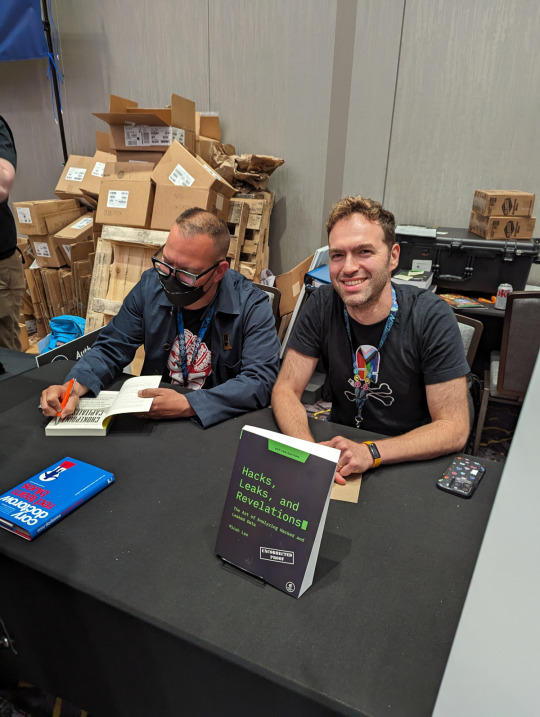
After my talk, I went back to the No Starch Press booth for a book signing – which was amazing, so many beautiful hackers, plus I got to share a signing table with Micah Lee. As I was leaving, Bill Pollock slipped me a giant hardcover art-book, and said, "You're gonna love this."
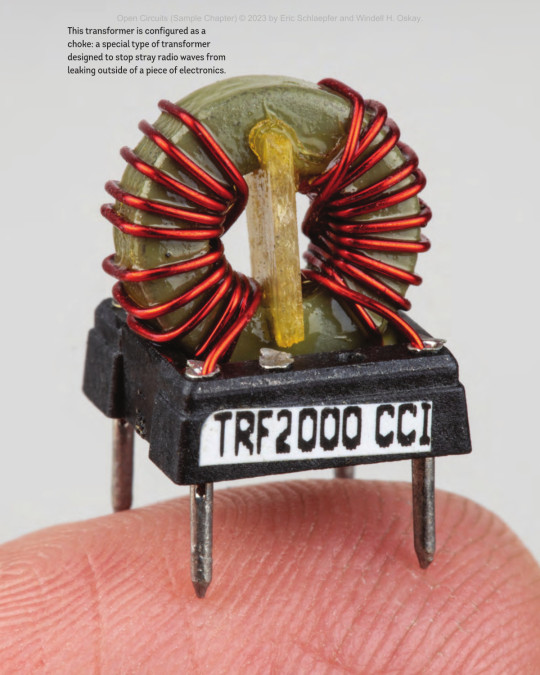
I did. The book is Open Circuits: The Inner Beauty of Electronic Components, by Windell Oskay and Eric Schlaepfer, and it is a drop-dead gorgeous collection of photos of electronic components, painstakingly cross-sectioned and polished:
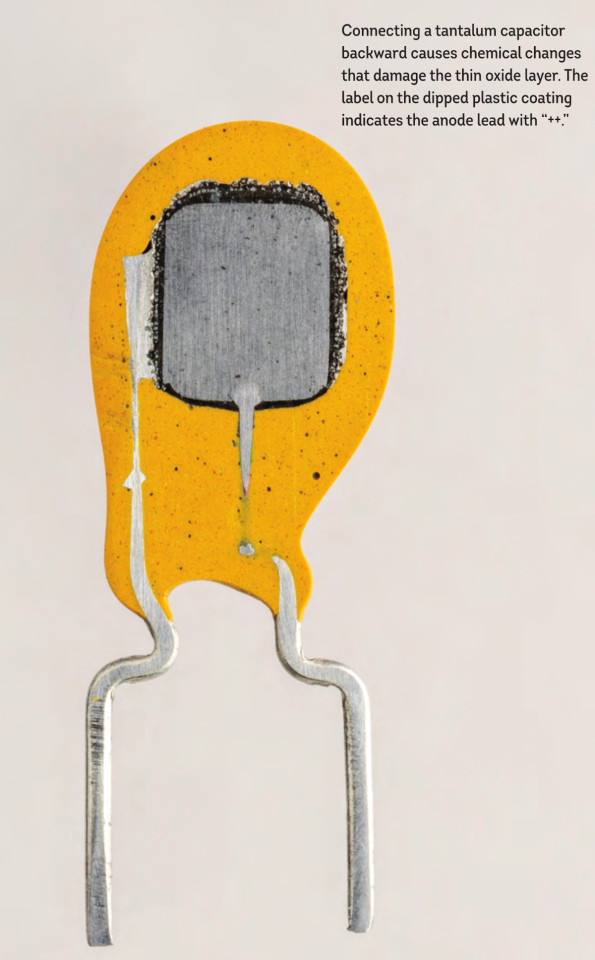
The photos illustrate layperson-friendly explanations of what each component does, how it is constructed, and why. Perhaps you've pondered a circuit board and wondered about the colorful, candy-shaped components soldered to it. It's natural to assume that these are indivisible, abstract functional units, a thing that is best understood as a reliable and deterministic brick that can be used to construct a specific kind of wall.
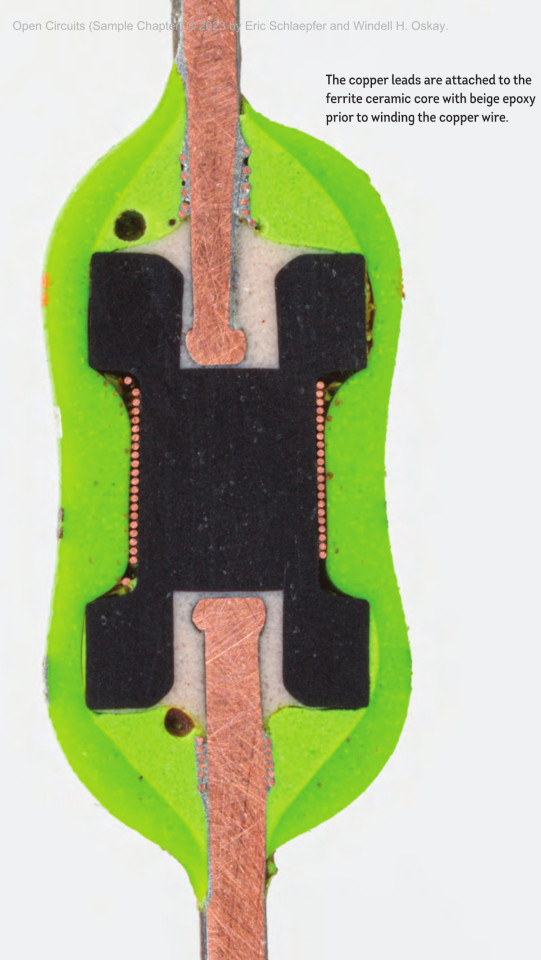
But peering inside these sealed packages reveals another world, a miniature land where things get simpler – and more complex. Inside these blobs of resin are snips of wire, plugs of wax, simple screws, fine sheets of metal in stacks, wafers of plain ceramic, springs and screws.
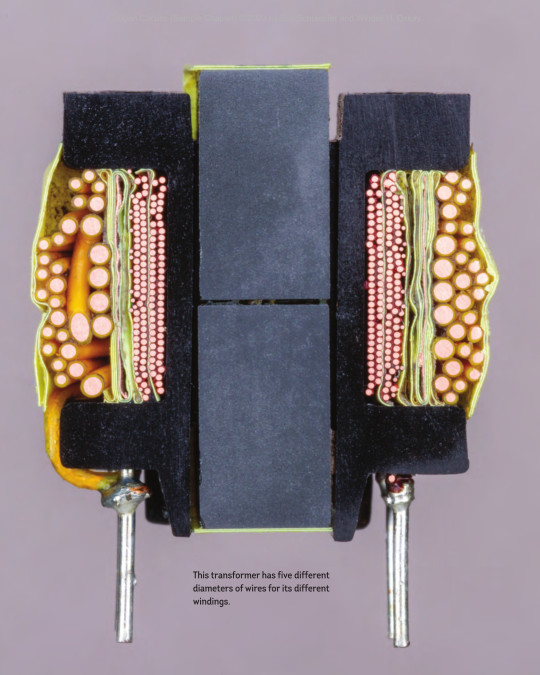
Truly, quantity has a quality all its own. Miniaturize these assemblies and produce them at unimaginable scale and the simple, legible components turn into mystical black boxes that only the most dedicated study can reveal. Like every magician's trick, the unfathomable effect is built up through the precise repetition of something very simple.

A prolonged study of Open Circuits reveals something important about the hacker aesthetic, a collection of graphic design, fashion and industrial design conventions that begins with this realization: that the crisp lines of digital logic can be decomposed into blobby, probabilistic lumps of metal, plastic, and even wax.

It reminds me of George Dyson's brilliant memoir/history of computing, Turing's Cathedral, where he describes how he and the other children of the scientists building the first digital computers at the Princeton Institute spent their summers in the basement, hand-winding cores for the early colossi their parents were building on the floors above them:
https://memex.craphound.com/2012/03/12/george-dysons-history-of-the-computer-turings-cathedral/
You can see my hacker aesthetic photos in my Defcon 31 photo set:
https://www.flickr.com/search/?sort=date-taken-desc&safe_search=1&tags=defcon31&user_id=37996580417%40N01&view_all=1
In this video, Eric Schlaepfer illustrates the painstaking work that went into decomposing these tiny, precise components into their messy, analog subcomponents. It's pure hacker aesthetic, and it's mesmerizing:
https://www.youtube.com/watch?v=byKyJ0b04Lo
But Open Circuits isn't just an aesthetic journey, it's a technical one. After all, Oskay is co-founder of Evil Mad Scientist Labs, one of the defining places where hardware hackers gather to tear down, pick apart, mod, improve and destroy electronics. The accompanying text is a masterclass in the simple machines that combine together to make complex assemblies:
https://www.evilmadscientist.com/
Defcon is a reminder that the world only seems hermetically sealed and legible to authorized parties with clearance to crack open the box. From shopping cart wheels to thermal fuses, that illegibility is only a few millimeters thick. Sand away the glossy outer layer and you will find yourself in a weird land of wax-blobs, rough approximations, expedient choices and endless opportunities for delight and terror, mischief and care.

Back my anti-enshittification Kickstarter here!

If you'd like an essay-formatted version of this post to read or share, here's a link to it on pluralistic.net, my surveillance-free, ad-free, tracker-free blog:
https://pluralistic.net/2023/08/14/hidden-worlds/#making-the-invisible-visible-and-beautiful
#pluralistic#books#reviews#evil mad scientist laboratories#no starch press#Windell Oskay#Eric Schlaepfer#electronics#hacker aesthetic#makers#diy#secret knowledge#gift guide#photography
93 notes
·
View notes